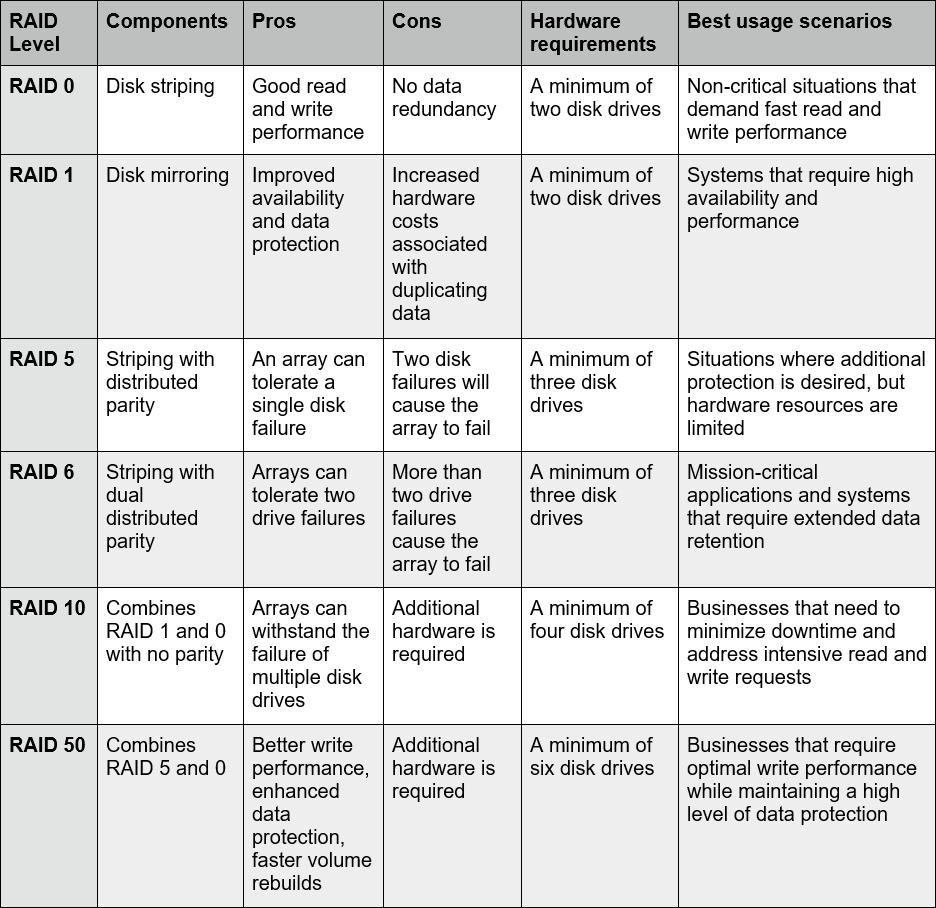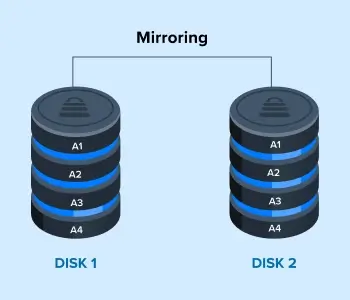Advantages of RAID for Business Data Storage:
-
Data Redundancy and Protection: RAID stores multiple copies or distributes parity data across drives, protecting against data loss from disk failures. This ensures business data remains accessible even if one or more drives fail, depending on the RAID level used.
-
Performance Improvement: Certain RAID configurations (e.g., RAID 0, RAID 10) enhance read/write speeds by striping data across multiple disks, allowing simultaneous operations and faster access to data.
-
Scalability: RAID arrays can be expanded by adding more drives, allowing businesses to increase storage capacity without downtime or complex reconfiguration.
-
Cost-Effectiveness: Using multiple lower-cost drives in RAID can be more economical than investing in a single high-performance drive, especially for large storage needs.
-
Versatility: RAID can be implemented on various devices, including servers, workstations, and personal computers, making it adaptable to different business environments.
Disadvantages of RAID for Business Data Storage:
-
Cost: Implementing RAID can be expensive due to the need for multiple drives, specialized hardware controllers (especially for hardware RAID), and supporting infrastructure like cooling and power systems.
-
Complexity and Maintenance: RAID setup and management require technical expertise. Misconfiguration can risk data integrity, and ongoing monitoring is necessary to detect and replace failing drives promptly.
-
Performance Overhead: Some RAID levels (e.g., RAID 5, RAID 6) involve parity calculations that can slow down write operations, potentially impacting performance in write-intensive business applications.
-
Single Point of Failure Risks: RAID is not a substitute for backups. If the RAID controller fails or multiple drives fail beyond the RAID level’s tolerance, data loss can occur. Additionally, rebuilding large drives after failure can be time-consuming and risky if other drives have bad sectors.
-
Increased Risk During Rebuilds: Since drives in an array often wear out simultaneously, the chance of a second drive failing during rebuild is higher, which can lead to total data loss in some RAID configurations.
Summary Table:
| Aspect | Advantages | Disadvantages |
|---|---|---|
| Data Protection | Redundancy protects against disk failure | Not a full backup; controller failure risk |
| Performance | Faster reads/writes with striping | Parity calculations can slow writes |
| Scalability | Easy to add drives to increase capacity | More drives increase complexity and cost |
| Cost | Uses multiple cheaper drives | High initial investment for drives and hardware |
| Maintenance & Setup | Versatile across devices | Requires expertise; complex to manage |
| Reliability During Rebuild | N/A | Risk of data loss if multiple drives fail |
RAID is a valuable technology for business data storage, offering a balance of performance and redundancy. However, it should be complemented with regular backups and careful management to mitigate its limitations.




















WebSeoSG offers the highest quality website traffic services in Singapore. We provide a variety of traffic services for our clients, including website traffic, desktop traffic, mobile traffic, Google traffic, search traffic, eCommerce traffic, YouTube traffic, and TikTok traffic. Our website boasts a 100% customer satisfaction rate, so you can confidently purchase large amounts of SEO traffic online. For just 40 SGD per month, you can immediately increase website traffic, improve SEO performance, and boost sales!
Having trouble choosing a traffic package? Contact us, and our staff will assist you.
Free consultation